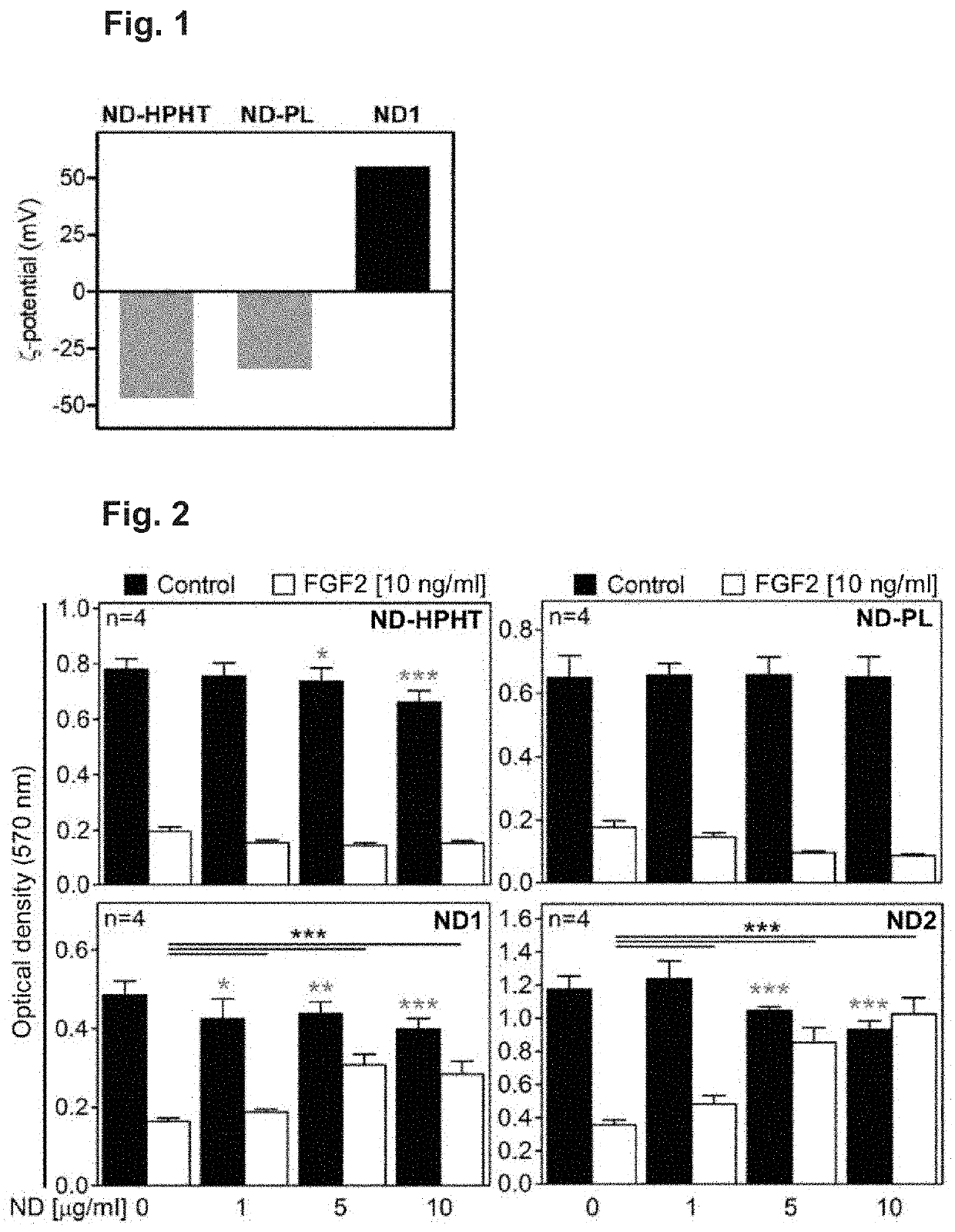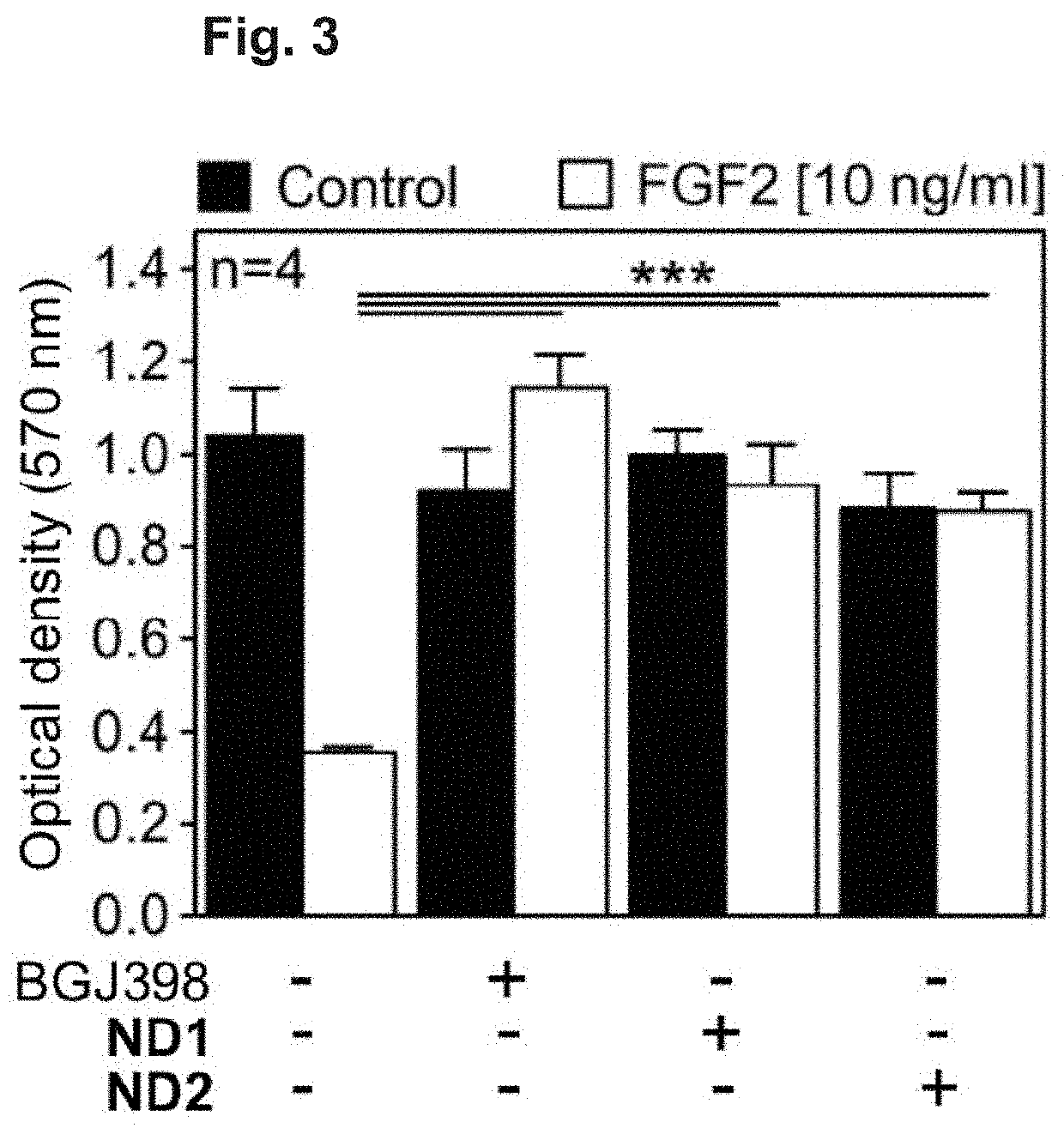Nanodiamonds as artificial proteins for regulation of a cell signalling system
a cell signalling system and nanoparticle technology, applied in the field of nanoparticles, can solve the problems of high difficulty in developing nanoparticles that selectively modulate protein-protein interactions, unsatisfactory side effects, and unfavorable side effects, so as to prevent side effects and avoid undesired side effects.
- Summary
- Abstract
- Description
- Claims
- Application Information
AI Technical Summary
Benefits of technology
Problems solved by technology
Method used
Image
Examples
example 1
Preparation of Nanodiamond (ND) Colloids:
[0045]ND1: The dispersion of detonation ND purchased from NanoAmando (10 ml, 5.0%) was diluted with water to a concentration of 10 mg / ml, sonicated for 10 min and filtered using a 0.2 μm PVDF syringe filter.
[0046]ND2: ND1 colloidal solution (40 ml, 10.3 mg / ml) was centrifuged in an ultracentrifuge Beckman Coulter Le80K with an SW 41 Ti swinging bucket rotor (15,000 rfc, 2 h). The supernatant was isolated and filtered using a 0.2 μm PVDF syringe filter, yielding ND2 colloid (26 ml, 7.8 mg / ml) with positive ξ-potential 49 mV and hydrodynamic diameter 21 nm.
[0047]ND-PL: The ND powder (3 mg) was mixed with 3 ml of water in a plastic tube and sonicated for 60 min using a probe sonicator in an ice bath. The obtained colloid was filtered using a 0.45 μm glass microfibre syringe filter.
[0048]HPHT NDs were oxidized by air in a Thermolyne 21100 tube furnace at 510° C. for 5 hours. The NDs were subsequently treated with a mixture of HNO3 and H2SO4 (90° ...
example 2
[0054]To compare the efficacy of ND1 and ND2 with an established approach to the inhibition of FGF signalling, we performed the FGF2 growth arrest assay with a small-molecule inhibitor of FGFR catalytic activity, BGJ398 (Guagnano, V.; Furet, P.; Spanka, C.; Bordas, V.; Le Douget, M.; Stamm, C.; Brueggen, J.; Jensen, M. R.; Schnell, C.; Schmid, H.; et al. Discovery of 3-(2,6-Dichloro-3,5-Dimethoxy-Phenyl)-1-{6-[4-(4-Ethyl-Piperazin-1-Yl)-Phenylamino]-Pyrimidin-4-Yl}-1-Methyl-Urea (NVP-BGJ398), a Potent and Selective Inhibitor of the Fibroblast Growth Factor Receptor Family of Receptor Tyrosine Kinase. J. Med. Chem. 2011, 54, 7066-7083), which is currently being evaluated in clinical trials for FGFR-driven cancer (Tanner, Y.; Grose, R. P. Dysregulated FGF Signalling in Neoplastic Disorders. Semin. Cell Dev. Biol. 2016, 53, 126-135). BGJ398 rescued the FGF2-mediated growth arrest phenotype to a similar extent to that of ND1-2 (FIG. 3).
example 3
[0055]For this experiment, ND1 were further purified by dialysis: ND1 colloidal solution (1 ml, 10 mg / ml) was dialysed 5× against water in 6-8 kDa dialysis tubing (Spectra / Por), filtered using a 0.2 μm PVDF syringe filter and diluted (9 ml, 1.0 mg / ml).
[0056]Similar to the growth arrest, the FGF2-mediated induction of premature senescence in RCS chondrocytes, manifested as the upregulation of the senescence markers lamin A / C and caveolin and the downregulation of ID2 (Krejci, P.; Prochazkova, J.; Smutny, J.; Chlebova, K.; Lin, P.; Aklian, A.; Bryja, V.; Kozubik, A.; Wilcox, W. R. FGFR3 Signaling Induces a Reversible Senescence Phenotype in Chondrocytes Similar to Oncogene-Induced Premature Senescence. Bone 2010, 47, 102-110), was rescued by both ND1 and ND2 (FIG. 4A).
[0057]To gain further insight into the mechanisms of the ND-mediated inhibition of FGF signalling, the effect of ND on the activation of FGFR signal transduction in RCS cells was explored. Treatment with FGF2 induced pot...
PUM
| Property | Measurement | Unit |
|---|---|---|
| Time | aaaaa | aaaaa |
| Diameter | aaaaa | aaaaa |
| Electric potential / voltage | aaaaa | aaaaa |
Abstract
Description
Claims
Application Information
 Login to View More
Login to View More - R&D
- Intellectual Property
- Life Sciences
- Materials
- Tech Scout
- Unparalleled Data Quality
- Higher Quality Content
- 60% Fewer Hallucinations
Browse by: Latest US Patents, China's latest patents, Technical Efficacy Thesaurus, Application Domain, Technology Topic, Popular Technical Reports.
© 2025 PatSnap. All rights reserved.Legal|Privacy policy|Modern Slavery Act Transparency Statement|Sitemap|About US| Contact US: help@patsnap.com



